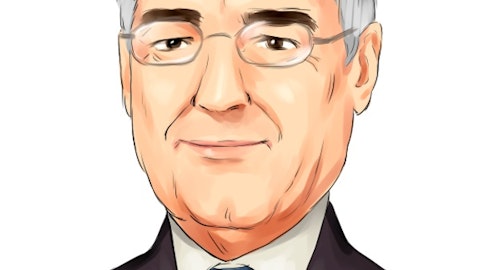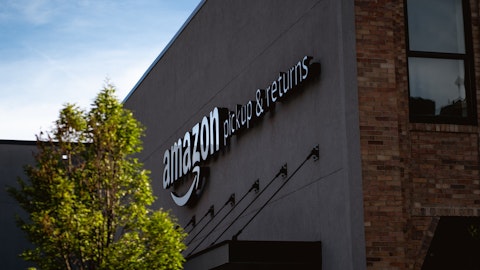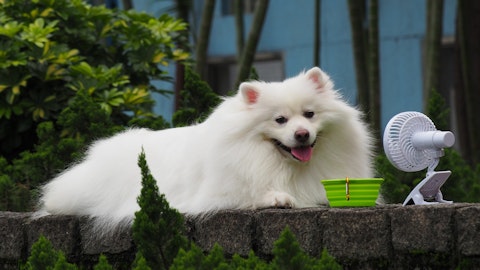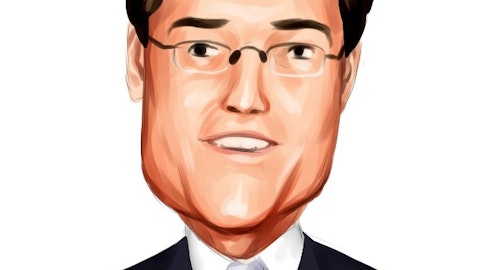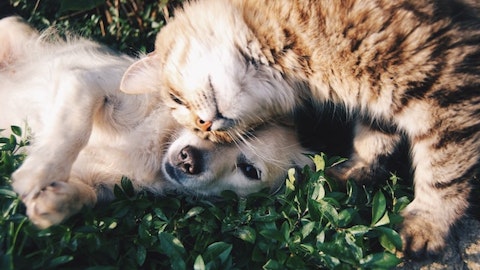Central Garden & Pet Company (NASDAQ:CENT) Q1 2023 Earnings Call Transcript January 31, 2023
Operator: Ladies and gentlemen, thank you for standing by. Welcome to Central Garden & Pet’s First Quarter Fiscal 2023 Earnings Call. My name is Shamali and I will be your conference operator for today. At this time, all participants are in a listen-only mode. Later, we will conduct a question-and-answer session. Instructions will be given at that time. As a reminder, this conference call is being recorded. I would now like to turn the call over to Friederike Edelmann, Vice President of Investor Relations. Please go ahead.
Friederike Edelmann: Thank you, Shamali. Good afternoon, everyone. Thank you for joining us. With me on the call today are Tim Cofer, Chief Executive Officer; Niko Lahanas, Chief Financial Officer; J.D. Walker, President, Garden Consumer Products; and John Hanson, President, Pet Consumer Products. As usual Tim will provide a business update, and Niko will discuss results for our first quarter ended December 24, 2022 in more detail. After the prepared remarks, J.D. and John will join us for the Q&A. Our press release and related materials are available at ir.central.com, and contains the GAAP to non-GAAP reconciliation for the non-GAAP measures discussed on this call. Lastly unless otherwise stated all growth comparisons made during this call are against the same period in the prior year.
Before I turn the call over to Tim, I would like to remind you that statements made during this call, which are not historical facts, including the potential impact of COVID-19 on our business, earnings per share and other guidance for fiscal 2023, expectations for new capital investments, product launches and future acquisitions are forward-looking statements subject to risks and uncertainties that could cause actual results to differ materially from those implied by forward-looking statements. These risks and others are described in Central’s filings with the Securities and Exchange Commission, including our Annual Report on Form 10-K filed on November 22, 2022. Central undertakes no obligation to publicly update these forward-looking statements to reflect new information, subsequent events or otherwise.
Now I will turn over the call to our CEO, Tim Cofer. Tim?
Tim Cofer: Thank you, Friederike, and good afternoon everyone. Let me begin by extending a sincere thank you to Team Central for their perseverance and execution in yet another challenging quarter. Three key messages for today’s call. First, our quarterly results. We delivered Q1 in line with the guidance we provided in November, which anticipated near-term challenges. These included unfavorable cost overhang from last year’s poor garden season, higher inventories at our retail partners, and a more sluggish demand environment compared with the strong growth quarter a year ago. As expected, these challenges put downward pressure on our key financial metrics. Net sales were $628 million, gross margin was 27.4%, and operating income was $400,000.
We had a loss per share of $0.16 in line with our guidance. Second, our outlook for the year. Our fiscal first quarter is traditionally our smallest quarter. As such, we don’t usually draw any major conclusions from Q1, especially since the 2023 garden season is still in front of us. For the remainder of the year, we assume a normal weather garden season and that inventory dynamics will stabilize and we expect our pricing actions and cost control measures to largely offset inflation. As such, we are maintaining our EPS guidance of $2.60 to $2.80 for the year. And third, our long-term outlook remains favorable. Both Pet and Garden are dynamic growth categories with numerous consumer trends that underpin sustainable growth potential for years to come.
We remain confident in the competitive strength of Central and our Central to Home strategy as the roadmap to create value for our customers and shareholders. Now let’s take a look at our two segments starting with Pet. Sales in the Pet segment were 5% below prior year largely due to our decision to discontinue low-profit private-label product lines, especially in pet beds. On a positive note, we saw robust sales growth in our dog and cat brands, as well as outdoor cushions. Pet remains an attractive growth category and while our sales were down in the quarter, we drove an increase in our POS by 6% versus prior year. This is a further indication that retailers are still working down their inventories and we expect that to normalize by the middle of the year.
Thanks to our investments in capacity expansion and automation in the last two years, our pet service levels are no longer a headwind and are now in the mid-to-upper nineties. Moreover, our efforts to grow capabilities around consumer insights, brand marketing and innovation are beginning to pay off as evidenced by market share gains in dog treats, dog toys, small animal, pet bird, aquatics and equine. Another near term dynamic impacting portions of our business is the change in pet adoption rates. Following a few years of growing pet ownership during the early COVID period, we are now seeing a flat to declining trend. This unfavorably impacts consumer demand for durables such as fish tanks, small animal enclosures, and other new pet durable goods.
The difference between consumable and durable sales trends is more than a ten-point spread in the recent quarter. Our eCommerce business continues to significantly outperform brick-and-mortar channels with solid growth in the first quarter, including double digit gross sales increases in our dog and cat businesses. eCommerce now represents approximately 23% of our pet consumer sales. We are continuing to prioritize investments in digital capabilities and talent, and we’re pleased with our eCommerce market share performance. Similar to our fiscal 2022 fourth quarter, we gained share broadly across pet supply categories on a leading pure play etailer, including aquatics, reptile, small animal, pet bird, dog treats, and dog toys. We keep a close eye on consumer behavior, including any change in purchasing patterns.
While there may be a shift to private label in a future recessionary environment, in aggregate, we continue to see our branded pet business outperforming private label. Turning now to our Garden segment, our fiscal first quarter typically represents only about 15% of annual Garden sales. So we’re careful not to read too much into this quarter, since the Garden season is still in front of us. We anticipated our first quarter would be challenged largely as a result of the overhang from last year’s poor Garden season, including higher inventory levels, unfavourable fixed cost absorption, and weaker demand. In addition, our top three customers saw lower foot traffic ranging from mid-single to low double digits below prior year. With that backdrop, our Garden sales declined 6% versus prior year, driven by weakness in live goods, and controls and fertilizers.
Bright spots were Wild Bird and Grass Seed, which both saw sales and market share growth. Wild Bird continues to be a strong business for us. The category has been reignited post-COVID with more and younger households participating in the hobby. And our Pennington brand is on its third consecutive year of market share growth. Grass Seed also grew sales and market share in the quarter, driven by recent innovation and improved marketing. While our overall Garden sales were down, we are encouraged by the low-single-digit growth in POS, which is lapping 14% POS growth in the prior year. This indicates that consumers remain engaged in the Garden categories. And as we move into Q2 and the back half, we will be lapping softer comps. Our customer fill rates are now consistently in the high 90s back to historic levels.
And while still a relatively small part of our Garden business, we’re pleased with our Q1 eCommerce POS growing 30% versus prior year. Now let me share a few quick comments on our strategy. We remain committed to our Central to Home strategy as the strategic roadmap to unlock value for our shareholders, and we continue to make good progress across a number of key priorities. In today’s call, I will focus on two of our strategic pillars, consumer and cost. First, our consumer pillar. Over the last few years, we’ve made investments in advancing our growth capabilities through talent acquisition, increased working media, bigger and better consumer-driven marketing and innovation ideas, and importantly improved tracking and measurement tools. The latest quarter suggests that our investments are beginning to pay off.
While the Q1 demand environment was sluggish for the reasons I previously outlined, we are growing our POS and our market share across both Pet and Garden in Q1, we are growing faster than our competition across the majority of our categories. And in the fastest growing sales channel, e-commerce, we are growing market share, especially in the largest pure-play platform. Second, shifting to our cost pillar. In fiscal 2023, the theme internally is all about cost and cash. This means we will take additional short-term actions to cut costs while developing longer term initiatives to build margins. It also means we are concentrating our efforts on reducing inventory and converting it into cash. We believe there’s a meaningful opportunity across Central to simplify our network, optimize our footprint, streamline our portfolio, and better leverage our supply chain scale across procurement, manufacturing, and distribution to improve our cost structure and build margins over time.
We are taking a measured approach here. This is about evolution, not revolution, and we’ll share more as we firm up our longer term plans to improve margins and fuel growth. So to summarize, we remain confident in the competitive strength of Central and our Central to Home strategy and the fundamental trends that support Pet and Garden industry growth. We knew that Q1 would be a challenging start to the year and as the year progresses, we assume a normal weather garden season and that inventory dynamics will stabilize and we expect pricing actions and cost control efforts to largely offset inflation. I remain confident in our team’s ability to navigate and perform. As such, we are maintaining our EPS guidance of $2.60 to $2.80 for the year.
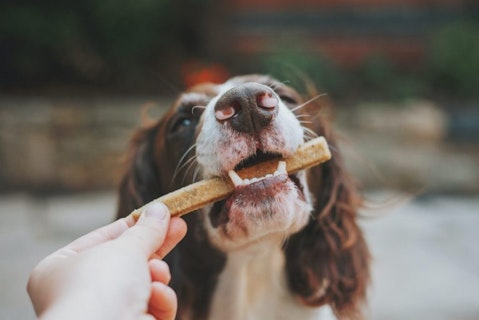
Photo by James Lacy on Unsplash
And with that, let me turn it over to Niko, who will share more details of our Q1 results. Niko?
Niko Lahanas: Thank you, Tim. Good afternoon, everyone. Building on Tim’s remarks, I’ll share with you details of our first quarter results for fiscal 2023. Net sales were $628 million, a decline of 5% as we are comping strong growth in the prior year first quarter. Consolidated gross profit was $172 million, a decrease of 13%. Gross margin of 27.4% was down 260 basis points, largely driven by our Garden segment due to further cost inflation and commodities and much lighter sales volumes, resulting in unabsorbed overhead, which were partially offset by our pricing actions. SG&A expense of $171 million was in line with prior year. However, SG&A as a percentage of net sales increased 130 basis points to 27.3% due to lower sales.
Operating income declined by $26 million to $406,000 and operating margin decreased 390 basis points to 0.1%. The decline was largely driven by our Garden segment, which saw continued cost inflation and unabsorbed overhead due to lower sales, which were partially offset by lower commercial spent. Net interest expense of $14 million was in line with the prior year quarter. We had a net loss of $8 million compared to net income of $9 million a year ago. Our loss per share was $0.16 compared to earnings per share of $0.16 in the prior year quarter. And adjusted EBITDA was $29 million compared to $52 million in the prior year. Our tax rate was 24.2% compared to 20.7% in the prior year quarter, due to a lower benefit from stock-based compensation.
Now provide some insights in the segments, starting with Pet. Pet segment sales of $416 million declined by 5%, driven by our decision to discontinue some low profit private label pet bedding product lines and SKU rationalization. Lower demand and durables especially in aquatics, strength in dog and cat and outdoor cushions partially offset the declines. Pet segment operating income declined by 13% to $40 million and operating margin decreased 90 basis points to 9.5%, largely driven by inflation and lower sales, partially offset by our pricing actions. Pet segment adjusted EBITDA was $50 million compared to $55 million a year ago. Turning now a Garden. Garden segment sales were $212 million down 6% due to lower sales in our live plant business and controls and fertilizer, which were partially offset by continued strength in wild bird and grass seed.
Garden segment operating loss was $11 million. Garden segment operating margin decreased to a negative 5.1%, mainly driven by inflation and the impact from lower sales, partially offset by our pricing actions. Garden segment adjusted EBITDA was breakeven compared to $16 million a year ago. Now moving to the balance sheet and cash flows. Cash and cash equivalents at the end of the first quarter were $88 million compared to $296 million a year ago. The decrease was mainly driven by inventory build over the last 12 months. About half of this build was cost inflation and the rest was volume to improve fill rates and also pre-build leading up to the garden season. Net cash used by operations was $63 million for the quarter compared to $92 million a year ago.
The decrease was mainly driven by lower working capital requirements. As Tim mentioned, we entered the year with higher inventory and built less inventory this quarter than in the first quarter a year ago. CapEx was $18 million for the quarter, 27% below prior year. Remember, last year we significantly invested in capacity expansion across our businesses. This quarter, we invested in dog and cat, small animal bedding, live plants, in our bird feed businesses. Total debt of $1.2 billion was in line with prior year. Our leverage ratio was 3.1 times at the end of the quarter compared to 2.9 times a year ago well within our target range. We had no borrowings under our credit facility at the end of the first quarter. Depreciation and amortization for the quarter was $22 million compared to $20 million in the prior year quarter, primarily driven by higher depreciation due to our recent investments in capacity expansion across our businesses.
During a quarter, we repurchased approximately 251,000 shares or $9 million of our stock. And finally, turning to our fiscal 2023 outlook, which remains unchanged from our guidance in November. That said, we continue to take into account the ongoing economic uncertainty, continued cost inflation, unfavorable retailer inventory dynamics, as well as changing consumer preferences as they continue to adjust to increased cost of living pressures. Nevertheless, we remain committed to our Central to Home strategy. However, in the near-term, we are taking a more deliberate approach to investments in our consumer growth agenda. As Tim said for fiscal 2023, we are squarely focused on cost and cash. This means we are tightening our belt, including a pause on hiring, a reduction in travel expenses, decreased CapEx to $70 million to $80 million of which the majority is carryover and maintenance, and we are working on converting inventories into cash.
Thanks to our strong financial position and the amount remaining on our credit facility, we remain on the lookout for great growth and margin accretive companies in both Pet and Garden. Lastly, we expect a tax rate in the range of 22% to 24% similar to 2022. All said, we continue to expect earnings per share for the year to be in the range of $2.60 to $2.80. Our guidance reflects our belief in the competitive strength of Central and the long-term trends supporting growth in the Pet and Garden industries. Consumers remain engaged in our categories as demonstrated by our POS consumption trends that have been consistently stronger than our shipments in both Pet and Garden. This gives us confidence in our full year guidance. And as we indicated in our November call, we expect fiscal 2023 to be skewed to the back half with EPS in the first two quarters below the prior year quarters and EPS growth in the second half.
As always, this outlook excludes any impact from potential acquisitions or restructuring activities undertaken during the year. And with that, we’d like to open the line for questions.
See also 25 Largest British Companies by Revenue and 12 Cash Rich Small Cap Stocks to Buy.
Q&A Session
Follow Central Garden & Pet Co (NASDAQ:CENT)
Follow Central Garden & Pet Co (NASDAQ:CENT)
Operator: At this time, we will be conducting a question-and-answer session. Our first question comes from Bill Chappell with Truist Securities. Please proceed with your question.
Bill Chappell: Thanks. Good afternoon.
Tim Cofer: Hey, Bill.
Niko Lahanas: Hey, Bill.
Bill Chappell: Hey, just want to talk a little bit more about kind of the POS numbers in the quarter and try to break that down between price and volume. I mean, I would expect that you had at least kind of a 5 point 5 percentage point tailwind from pricing into this quarter. And so I didn’t know if you’re seeing volume still up on a year-over-year basis in Pet and Garden and as you look forward, will you lap that pricing where we could see things turn downward on POS or do you have enough pricing to carry sales growth into 2023?
Tim Cofer: Sure. Thanks, Bill. Look, our pricing continues to be an important part of the overall algorithm in this inflationary environment. And as you look at Q1, we priced again in the high singles. That’s a good chunk of that is carry over on pricing actions that we took in the last fiscal and then some select new pricing actions in the first quarter. As it relates the volume impact of that, we monitor that closely on a regular basis business by business. We continue to see an elasticity around one, meaning, we’re seeing that upper single digit volume decay off that upper single digit pricing. And that’s more or less our expectation. Obviously the mileage varies, we have some views that are more elastic, some businesses and brands than others, but in aggregate that’s what you see.
As you go to the balance of the year, we still have a new pricing. We’ve got some pricing in this quarter meaning now we’re in the second quarter as you know, our fiscal second quarter that’s landed. Our overall pricing envelope when you look at it in aggregate around a couple hundred million bucks, it is north of 90% landed with our customers. So we feel good that it will come through. Again, the wildcard, if there is one, is any sort of changes in elasticity versus our assumptions. And I think when you look at that pricing envelope for the balance of the year, and you compare that to our view on the inflationary envelope, we feel pretty good as I said in my prepared remarks, that we’ll be able to between pricing and our cost control efforts largely cover that inflation.
POS finally is, as you heard, remains strong and in positive territory. So while net sales was down in both Pet and Garden for the reasons that you heard on the prepared remark call. POS is up and it’s up mid single digits on Pet and it’s up single digits on Garden. So that we feel good about.
Bill Chappell: Great. And then on gross margin, it was obviously down year-over-year, but still a little bit better than I was anticipating. Is that driven in part by just the mix shift in Pet of more consumables versus durables and is that something that continues or was that not that significant?
Tim Cofer: Yes, I mean that played a role, the other piece too is we also got out of some private label bedding, which is lower margins. So some of that was also intentional on the Pet side and but yes, a lot of it is the shift to consumables from the durable area. And Bill, the good news on Pet is gross margin on the quarter was basically flat. The gross margin degradation at a company level was Garden driven as Niko said on the call. And that’s for the reasons that I think Niko shared and we certainly can elaborate on further. But overall, I’d say on gross margin, feeling pretty good about being able to hold on the water line on Pet and a little bit challenged in the first quarter on Garden as we anticipated. We also had some of our higher margin businesses outperform in the quarter on the Pet side as well. So that helped margin.
Bill Chappell: Got it. And last one for me. Just kind of early read in terms of how the retailers are thinking on the garden season. This is obviously the season hasn’t really kicked off with the weather. But yes, I may imagine you have a pretty good idea whether they’re all in, half in, not really sure if they’re in for the season. Thinking of last year, trying to figure out whether it was more last year’s weakness was more weather related or more return to normal consumer patterns related. So what are you hearing or seeing from your retail partners right now in terms of how they’re set up for 2023?
J.D. Walker: Hi, Bill, it’s JD. I’ll take that question. I’d say the feedback we’re getting from our retailers is overall very bullish. They do think that last year was mainly a weather driven challenge more than anything else. This year what they’ve done is take a more measured approach to flowing the goods to stores to set the stores at the beginning of the season. But we’ve seen some nice pickup in POS. In fact, POS and shipments have both rebounded very nicely after the end of the quarter in early January here. So in my conversations with the retailers they’re saying that they’re going to take an aggressive approach once the season starts to break. The good news is we’re up against some pretty weak comps for the next couple of months.
And I think if the retailers see that it’s going to embolden them to be more even more bullish on the season, I think most of our season is going to our consumption is going to take place between March and mid-June. And I think by then, first of all, we feel very good about our off shelf activity, our promotional activity, but the retailers seem to be remain engaged. And when we’ve had decent weather, doesn’t have to be stellar, but when we’ve had just decent weather, the consumer’s very active in our company. I think once all that comes together, we are cautiously optimistic, but the retailers are very much engaged and bullish.
Bill Chappell: Great. Thanks so much.
